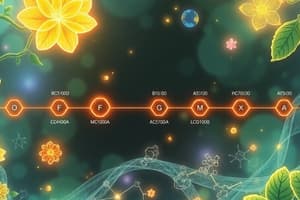Podcast
Questions and Answers
What is the result of modifications to aromatic amino acids, benzoic acids, and cinnamic acids derivatives?
What is the result of modifications to aromatic amino acids, benzoic acids, and cinnamic acids derivatives?
- Terpenoid quinones and isoflavonoids
- Flavonolignans and volatile oils
- Styrylpyrones and flavonoids
- Lignans and lignin, phenylpropenes, and coumarin (correct)
Which combination of pathways leads to the formation of flavonoids and stilbenes?
Which combination of pathways leads to the formation of flavonoids and stilbenes?
- Shikimate pathway with the terpenoid pathway
- Shikimate pathway with the acetate pathway (correct)
- Shikimate pathway alone
- Acetate pathway with the terpenoid pathway
What is the result of combining the shikimate pathway with the terpenoid pathway?
What is the result of combining the shikimate pathway with the terpenoid pathway?
- Formation of terpenoid quinones (correct)
- Formation of phenylpropenes and coumarin
- Formation of flavonoids and stilbenes
- Formation of lignans and lignin
Which of the following is NOT a medicinal agent mentioned?
Which of the following is NOT a medicinal agent mentioned?
What is the common theme among the compounds mentioned, such as folic acid, chloramphenicol, and warfarin?
What is the common theme among the compounds mentioned, such as folic acid, chloramphenicol, and warfarin?
What is a common characteristic of lignans, lignin, and phenylpropenes?
What is a common characteristic of lignans, lignin, and phenylpropenes?
Which of the following is formed through the combination of the shikimate pathway and the acetate pathway?
Which of the following is formed through the combination of the shikimate pathway and the acetate pathway?
What is the function of folic acid, vitamin E, and vitamin K?
What is the function of folic acid, vitamin E, and vitamin K?
What is the characteristic of flavonolignans and isoflavonoids?
What is the characteristic of flavonolignans and isoflavonoids?
Which of the following compounds is NOT a derivative of aromatic amino acids, benzoic acids, and cinnamic acids?
Which of the following compounds is NOT a derivative of aromatic amino acids, benzoic acids, and cinnamic acids?
Flashcards are hidden until you start studying
Study Notes
Aromatic Amino Acid Derivatives
- Modifications of aromatic amino acids, benzoic acids, and cinnamic acids lead to the formation of lignans, lignin, phenylpropenes, and coumarin.
Combinations of Shikimate and Acetate Pathways
- The combination of the shikimate pathway and the acetate pathway leads to the formation of styrylpyrones, flavonoids, stilbenes, flavonolignans, and isoflavonoids.
Terpenoid Quinones
- Terpenoid quinones are formed by combining the shikimate pathway with the terpenoid pathway.
Medicinal Agents
- Folic acid is a medicinal agent derived from these pathways.
- Chloramphenicol is a medicinal agent derived from these pathways.
- Podophyllum is a medicinal agent derived from these pathways.
- Volatile oils are medicinal agents derived from these pathways.
- Dicoumarol and warfarin are medicinal agents derived from these pathways.
- Psoralens are medicinal agents derived from these pathways.
- Phyto-oestrogens are medicinal agents derived from these pathways.
- Vitamin E is a medicinal agent derived from these pathways.
- Vitamin K is a medicinal agent derived from these pathways.
Aromatic Amino Acid Derivatives
- Modifications of aromatic amino acids, benzoic acids, and cinnamic acids lead to the formation of lignans, lignin, phenylpropenes, and coumarin.
Combinations of Shikimate and Acetate Pathways
- The combination of the shikimate pathway and the acetate pathway leads to the formation of styrylpyrones, flavonoids, stilbenes, flavonolignans, and isoflavonoids.
Terpenoid Quinones
- Terpenoid quinones are formed by combining the shikimate pathway with the terpenoid pathway.
Medicinal Agents
- Folic acid is a medicinal agent derived from these pathways.
- Chloramphenicol is a medicinal agent derived from these pathways.
- Podophyllum is a medicinal agent derived from these pathways.
- Volatile oils are medicinal agents derived from these pathways.
- Dicoumarol and warfarin are medicinal agents derived from these pathways.
- Psoralens are medicinal agents derived from these pathways.
- Phyto-oestrogens are medicinal agents derived from these pathways.
- Vitamin E is a medicinal agent derived from these pathways.
- Vitamin K is a medicinal agent derived from these pathways.
Studying That Suits You
Use AI to generate personalized quizzes and flashcards to suit your learning preferences.




